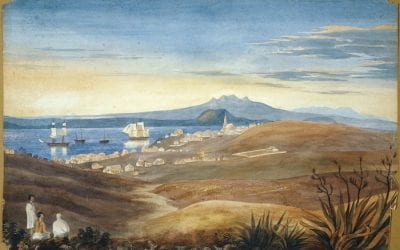AHI Summer Research Scholarships
Research Articles
1920s Fashion in Auckland, New Zealand
by Caitlin Kilpatrick*
“When, in future years, some energetic historian sets out to write the last word on the evolution of the world’s fashions, he or she as the case may be – probably he – will need to ponder seriously over Spring 1927.”
Treatment of our Lunatics: The Lunatics Act of 1868
Part Four Treatment of our Lunatics: The Lunatics Act of 1868Part One Prisoners to Patients – the Pre-Asylum State of Mental Health Care in AucklandPart Two A Work of Art: Constructing the Asylum at the WhauPart Three Wide Plains and Padded Cells: The Anatomy of an...
Wide Plains and Padded Cells: The Anatomy of an Asylum
Part Three Wide Plains and Padded Cells: The Anatomy of an AsylumPart One Prisoners to Patients – the Pre-Asylum State of Mental Health Care in AucklandPart Two A Work of Art: Constructing the Asylum at the WhauPart Four Treatment of our Lunatics: The Lunatics Act of...
A Work of Art: Constructing the Asylum at the Whau
Part Two A Work of Art: Constructing the Asylum at the WhauPart One Prisoners to Patients – the Pre-Asylum State of Mental Health Care in AucklandPart Three Wide Plains and Padded Cells: The Anatomy of an AsylumPart Four Treatment of our Lunatics: The Lunatics Act of...
Prisoners to Patients – the Pre-Asylum State of Mental Health Care in Auckland
by Sasha Finer*
“A glance at the report of the inquest will show the evil of committing people of diseased mind to either the gaol or hospital. If any one ever required special treatment – medical, hygienic, or domestic – it is the lunatic.”
“Out of the Closets and into the Streets”: Conceptualising Auckland as a Queer Space
Part Four “Out of the Closets and into the Streets”: Conceptualising Auckland as a Queer SpacePart One Opening the Door to the Private Spaces of Auckland’s Queer CommunitiesPart Two “This was Paradise”: The Rise of Queer Public Spaces in Central AucklandPart Three...
Gatekeeping in Auckland’s Queer Public Spaces from 1975 – 1985
Part Three Gatekeeping in Auckland’s Queer Public Spaces from 1975 – 1985Part One Opening the Door to the Private Spaces of Auckland’s Queer CommunitiesPart Two “This was Paradise”: The Rise of Queer Public Spaces in Central AucklandPart Four “Out of the Closets and...
“This was Paradise”: The Rise of Queer Public Spaces in Central Auckland
Part Two “This was Paradise”: The Rise of Queer Public Spaces in Central AucklandPart One Opening the Door to the Private Spaces of Auckland’s Queer CommunitiesPart Three Gatekeeping in Auckland’s Queer Public Spaces from 1975 – 1985Part Four “Out of the Closets and...
Opening the Door to the Private Spaces of Auckland’s Queer Communities
by Freiderike Voit*
In 1986, the Homosexual Law Reform Act legalised sex between men aged sixteen and over. This law change was the culmination of a decade and half of political discussion, and had mobilised New Zealanders to voice their opinions on homosexuality in over 1100 submissions to the Justice and Law Reform Select Committee.
The effects of the Waikato War on Ngāti Te Ata Waiōhua
Part Five The effects of the Waikato War on Ngāti Te Ata WaiōhuaPart One Understanding historic Māori fluidity within Ngāti Te Ata Waiōhua: An outlinePart Two Te Whakapapa o Ngāti Te Ata Waiōhua The Whakapapa of Ngāti Te AtaPart Three The fluidity of Ngāti Te Ata...
Diversity of thought and action within historic Ngāti Te Ata Waiōhua
Part Four Diversity of thought and action within historic Ngāti Te Ata WaiōhuaPart One Understanding historic Māori fluidity within Ngāti Te Ata Waiōhua: An outlinePart Two Te Whakapapa o Ngāti Te Ata Waiōhua The Whakapapa of Ngāti Te AtaPart Three The fluidity of...
The fluidity of Ngāti Te Ata rohe
Part Three The fluidity of Ngāti Te Ata rohePart One Understanding historic Māori fluidity within Ngāti Te Ata Waiōhua: An outlinePart Two Te Whakapapa o Ngāti Te Ata Waiōhua The Whakapapa of Ngāti Te AtaPart Four Diversity of thought and action within historic Ngāti...



